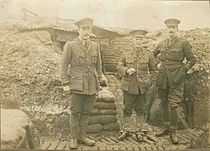George Carter-Campbell
| General George Carter-Campbell CB DSO | |
|---|---|
 General Carter-Campbell | |
| Born |
1869 Edinburgh |
| Died |
1921 (aged 51 or 52) London |
| Allegiance | United Kingdom |
| Service/branch | British Army |
| Years of service | 1889-1921 |
| Rank | Major-General (1915) |
| Battles/wars |
Second Boer War, First World War |
| Awards |
Order of the Bath Distinguished Service Order Order of St. Stanislaus Légion d'honneur Croix du Commandeur Mentioned in Despatches |
| Relations |
Thomas Carter (Rt. Hon., M.P., Secretary of State and Master of the Rolls), General George Campbell of Inverneill, C.B., K.A Admiral John Carter, Colonel Alexander Campbell of Possil, Major General Sir Archibald Campbell, General Sir James Campbell of Inverneill, Colonel Duncan Carter-Campbell of Possil, Willoughby Harcourt Carter |
Major-General George Tupper Campbell Carter-Campbell CB, DSO[1] (see Carter-Campbell of Possil) (1869–1921), was commissioned in October 1889 as a second-lieutenant into the Cameronians 2nd Scottish Rifles and served in the Second Boer War as adjutant of that battalion, being promoted Brevet Major and twice mentioned in despatches.[2]


On the outbreak of the First World War, Carter-Campbell proceeded to France[3] with the 8th Division as second-in-command of the 2nd Scottish Rifles[4] and was wounded at Neuve Chapelle[5] on 10 March 1915,[6] being awarded the D.S.O. and also the Order of St. Stanislaus. He subsequently commanded the Battalion until 23 September 1915, when he was appointed Brigadier-General to command the 94th Infantry Brigade. While holding the latter command, he was gazetted Brevet-Lieutenant-Colonel and finally Brevet-Colonel.[7]
He assumed command of the 51st Division[8] on 17 March 1918 and was its G.O.C. until he was transferred to the Rhine to take command of a brigade there, shortly before the division preceded home for demobilization. While in command of the Division, Carter-Campbell was awarded the C.B. and the French Legion of Honour (Croix du Commandeur).[9]
Major General Carter-Campbell was wounded during the First World War. After the war had ended, and he had recovered sufficiently, he was made General officer commanding Northern Ireland in 1920.[10]
Notes
- ↑ Imperial War Museum (Great Britain), Malcolm Brown (1996). The Imperial War Museum book of the Somme. Sidgwick & Jackson, in association with the Imperial War Museum.
- ↑ Arthur Mumby, Frank; David Hannay (1996). The great World War: a history. Volume 8 (Gresham).
- ↑ Great Britain. Parliament. House of Commons (1920). The Parliamentary debates (official report).: House of Commons. H.M.S.O.
- ↑ William Sheehan (2009). Hearts & mines: the British 5th Division, Ireland, 1920-1922. Collins Press.
- ↑ Who was who: a companion to Who's who : containing the biographies of those who died during the period. A. & C. Black. 1967.
- ↑ Moore, William (1970). The forgotten victor: General Sir Richard O'Connor, KT, GCB, DSO, MC,. Leo Cooper Ltd.
- ↑ Sir Arthur Conan Doyle (1920). A history of the great war, Volume 6. George H. Doran company.
- ↑ Malcolm Baynes, John Christopher (1989). The forgotten victor: General Sir Richard O'Connor, KT, GCB, DSO, MC,. Brassey's.
- ↑ James E. Edmonds (1995). Military Operations, France and Belgium, 1918. Issue 37 of Great War Series (Battery Press).
- ↑ Arthur Grenfell Wauchope (1926). A history of the Black Watch Royal Highlanders in the great war, 1914-1918. Volume 2 (The Medici society limited).
External links
- http://www.pals.org.uk/sheffield/city_diary.htm
- http://www.johndclare.net/wwi3_rees.htm
- http://net.lib.byu.edu/estu/wwi/memoir/docs/51st/51st4.htm
- A selection of books referring to General Carter-Campbell
See also
| ||||||||||||||
| Wikimedia Commons has media related to People from Edinburgh. |